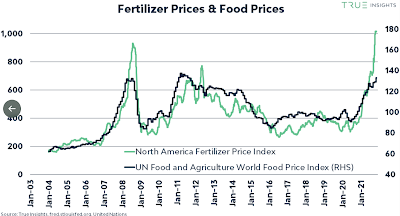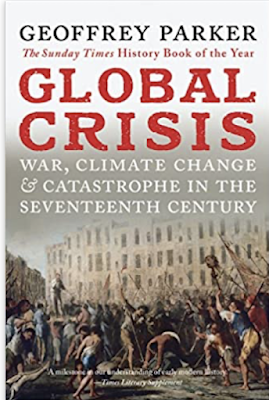Those who live in the United States have been blessed with abundance that has surrounded them since the day they were born.
That is not the case for many people in the world today.
It most certainly has been the exception for most humans throughout history.
The most fundamental resources that humans need are food and water.
45% of the world's fresh water resources are in the Americas.
On a per inhabitant basis, North America has 4x the fresh water that Western Europe has, 3x the amount that Africa has and 4.5x what Asia must subsist on.
For most of history, people had to hunt and scavenge for their food every day. They had to be near sources of fresh water.
The wonders of modern agriculture in the United States and in other advanced agricultural nations around the world have freed many people from that daily struggle to survive.
That is most certainly the case in the United States although too many people struggle to have the money to share in the abundance.
However, 41.7 million Americans who are on the lower end of income spectrum, receive food stamps each month at a cost to the taxpayers of almost $10 billion per month to insure no one is hungry. That is up from $7.7 billion per month last year.
The numbers above do not include additional funds allocated under Covid relief that provides Pandemic-EBT dollars for families with children. An additional $25 billion has been spent on this program over the last 12 months to insure no child in America is hungry.
Consider the output of the American farmer over time.
 |
| Source: https://www.usda.gov/media/blog/2020/03/05/look-agricultural-productivity-growth-united-states-1948-2017 |
Total farm production nearly tripled between 1948 and 2017 even though land and labor used in farming declined. Innovations in animal and crop genetics, chemicals, equipment and farm organization have enabled the growth in farm output.
Despite 3x the output, labor inputs during the period declined by 76%.
Land dedicated to farming declined by 28%.
Other inputs grew in use to offset the declines in labor and land.
What were those two other large inputs according to the Department of Agriculture?
Energy and agricultural chemicals (fertilizer).
If you think food prices are already high right now we may not have seen anything yet.
The prices we are seeing now do not have the full effect of the increases in oil and gas costs fully baked in.
Even more concerning looking to the next crop season, is what is going on in the fertilizer market. Costs have exploded for this agriculture critical item.
However, my concerns extend beyond price. There are questions of whether farmers will even be able to obtain the fertilizer supply they need for the coming growing season.
If that is the case, the abundance we have become accustomed to may be threatened. Could we begin to see food scarcity?
This would have been unthinkable a year ago. It no longer is.
This would not result from natural forces like climate or Covid. This would be largely attributable to political policy decisions. Cancelling pipelines. Limiting oil and gas exploration. Badgering oil and gas executives. Raising royalty rates on federal lands. To use a sports term, it is an unforced error.
Let's look a little deeper.
This is not a very comforting headline from Fortune magazine quoting the head of a large Norwegian fertilizer company.
 |
"I want to say this loud and clear right now, that we risk a very low crop in the next harvest," said Svein Tore Holsether, the CEO and president of the Oslo-based company. "I’m afraid we’re going to have a food crisis."
Speaking to Fortune on the sidelines of the COP26 climate conference in Glasgow, Holsether said that the sharp rise in energy prices this summer and autumn had already resulted in fertilizer prices roughly tripling.
Ammonia is a key ingredient in synthetic fertilizer which increases crop yields. The process of creating ammonia relies on substantial amounts of natural gas.
"To produce a ton of ammonia last summer was $110," said Holsether. "And now it's $1,000. So it's just incredible."
Yes, natural gas, that evil fossil fuel that Joe Biden and the Democrats want to ban because it MIGHT cause climate change in 10, 50 or never years. Its price has exploded and so has the price of ammonia and everything else that goes into fertilizer.
What is Joe Biden doing about it?
He stated last Friday that he wants to raise the royalty rates that oil and natural gas producers pay to drill on federal land.
He is raiding the Strategic Petroleum Reserve at the same time that he wants to raise the price to drill for oil and gas in the United States?
 |
| Source: https://www.nbcnews.com/politics/white-house/biden-administration-seeks-raise-price-drill-oil-gas-public-lands-n1284729 |
There is not a lot of strategic thinking going on in Joe Biden's head.
Don't worry if our food supply crumbles in the meantime. However, we can bask in the glory of successfully cutting off our supply of abundant, accessible and affordable fossil fuels that power our society.
This chart provides some context on the major raw material prices that go into agricultural fertilizer.
Do you see a problem here?
 |
| Source: https://twitter.com/FertilizerMkts/status/1463516746904649731/photo/2 |
Many farmers are delaying buying the nitrogen fertilizer they usually buy now for the next planting season because of the high prices. You have to remember that is a large upfront purchase that the farmer has to make with no promise of return until their crop is harvested next Fall.
However, the problem is the price could be higher toward the Spring and the risk may be that they will not be able to get the supply they need at any price at that time.
This puts farmers in a difficult position. How many will not plant at all this coming year or use less fertilizer that will diminish yields?
 |
| Source: https://www.theguardian.com/environment/2021/nov/25/fertilizer-shortage-north-america-farmers-food-prices |
A global shortage of nitrogen fertilizer is driving prices to record levels, prompting North America’s farmers to delay purchases and raising the risk of a spring scramble to apply the crop nutrient before planting season.
Farmers apply nitrogen to boost yields of corn, canola and wheat, and higher fertilizer costs could translate into higher meat and bread prices.
World food prices hit a 10-year high in October, according to the UN food agency, led by increases in cereal crops such as wheat and vegetable oils.
This chart gives you an idea of how much fertilizer prices have increased in the United States since last year.
 |
| Source: https://twitter.com/FertilizerMkts/status/1463516746904649731/photo/1 |
There is also a strong correlation between fertilizer prices and food prices.
 |
| Source: https://twitter.com/FertilizerMkts/status/1463516746904649731/photo/4 |
This would suggest that food prices are going much higher in the next year than we are seeing right now.
The new fertilizer prices haven't even started to be worked into food prices to any significant degree as yet.
All of this gives me a lot of cause for concern.
Will fertilizer prices stabilize?
Will they go down?
What is this going to do to crop yields in 2022?
Where are food prices going?
Could this actually result in food shortages?
Are we moving from an age of abundance to one of scarcity?
All of these questions also lead to some troubling geopolitical questions.
History has shown that populations get increasingly angry when there is not enough to eat.
The 17th Century was plagued by political and demographic disasters caused by food shortages.
It is chronicled in this book by Geoffrey Parker.
Interestingly, those food shortages were caused by a period of global cooling that caused longer and harsher winters and cooler and wetter summers. This resulted in disrupted growing seasons that caused famine, malnutrition, death, disease and fewer births. That led to political upheaval including invasions, wars and revolutions.
That is why I have said before that given a choice between global cooling and warming I would choose warming every time for the simple reason it is extends growing seasons around the planet.
People really do get angry when they are hungry.
Why then are Biden and the Democrats intent on policies that increase the cost of energy, which increases the cost of fertilizer and other farm costs, which then increases the cost of food which undoubtedly will cause more people to be hungry?
Let's not forget that this is being done by rejecting our most abundant and affordable energy sources (coal, oil natural gas) for scarce, unpredictable and expensive alternatives.
Are we really trading abundance for scarcity?
Let's hope we are not on our way to adding more to the Global Crisis we are already in.
I am not interested in revisiting the 17th Century.
However, we seem to be heading in that direction with each succeeding day.


As usual a great article. I believe you are being disingenuous when you say Biden has no plan. This is the plan. Scarcity, collapse, hunger will make people bend to the demands. We are entering a solar minimum so it will get colder in addition to a shortage of fertilizer. Everyone needs how to have container gardens if they don't have a big enough yard for a real garden. Thanks again - I always look forward to your articles!
ReplyDeleteI must have not been in clear in my writing. Biden and the Democrats clearly have a plan to destroy the oil and gas industry without considering the overall costs to society. It is the same with Covid. All of the focus is on trying to shut down the virus without regard to the bigger picture. I did not say there was no plan. I said Biden was not a strategic thinker. I know some think that all of this is a grand plan to cause global collapse. It's possible but I don't think "they" are that smart. Biden certainly is not. It is about political power and control, there is no doubt about that.
Delete